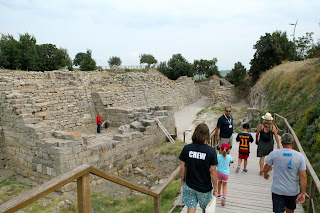 |
| Genuine Trojan! |
It was the wind that brought the wealth to Troy.
 |
| Troia (Troy) was right on the coast 3000 years ago. Silting was what moved it slowly inland to where is is today. |
Situated on the southern shore at the entrance the Dardanelles, all north bound ships were forced to anchor here and wait for a rare southerly wind to blow them up the Dardanelles, through the Sea of Marmara to Constantinople (Istanbul) and on through the Bosphorus to the Black Sea.
 |
| The shipping lanes today |
In the days of Troy, all these ships with nothing to do but wait and spend money in Troy. A fabulously wealthy and impregnable city with walls and ramparts high enough to withstand a 10 year siege against the entire Grecian army as they tried to reclaim Helen who had been stolen from them by Prince Paris of Troy.
 |
| The tacky version of the Horse at Troy |
 |
| The actual Trojan Horse from the movie Troy at the harbour in Canakkale |
When the Trojans came to inspect they were conned into believing the siege was finally over. They understood the Trojan horse to be a gift from the Greeks to the Trojan gods that they may grant them safe passage back to Greece.
Jubilant the Trojans dragged the horse back to the castle and celebrated large way into the wee hours...
Once the city was comatosed, those Greek soldiers hiding inside the horse easily overthrough the guards, opened the gates and the waiting hordes rushed in and ruined what must have been the most exquisite of places.
The Greeks got the gold but they didn't get Helen
 |
| The flat ground you see here was once Troy Harbour which silted up, became a swamp, has now been drained to produce agricultural perfection. |
Just like digital cameras killed Kodak, Smart Phones crippled Blackberry and Nokia and the Cloud caused the mighty Reckon Ltd to pivot and adapt.... so the ability to sail upwind spelled the end for Troy around 3000 years ago!
The abbreviated version of the discovery and excavation of Troy goes like this...
 As earlier stated, it is the setting of the Trojan War described in the Greek Epic Cycle and especially in the Iliad, one of the two epic poems attributed to Homer. (That bit was right out of Wikipedia by the way)
As earlier stated, it is the setting of the Trojan War described in the Greek Epic Cycle and especially in the Iliad, one of the two epic poems attributed to Homer. (That bit was right out of Wikipedia by the way)It was after reading this and other documents that convinced English archaeologist Frank Calvert to buy some land from a farmer at Hisarlik where he felt sure Troy had been buried over the millennia and in 1865 he started digging.
 Heinrich Schliemann, a wealthy German businessman and archaeologist, also began excavating in the area after a chance meeting with Calvert in Çanakkale.
Heinrich Schliemann, a wealthy German businessman and archaeologist, also began excavating in the area after a chance meeting with Calvert in Çanakkale.These excavations revealed several cities built in succession, one atop the other dating back to the Bronze Age. Schliemann was at first skeptical about the identification of Hisarlik as Troy, but was persuaded by Calvert and took over Calvert's excavations on the eastern half of the Hisarlik site, which was on Calvert's property.
 |
| A place of animal sacrifice. The plinth for the slaughter the circular 'wells' for the blood. Appeased the Gods. Still happens in certain religions today. |
Not a nice man Mr Schliemann. He cut a deal with the Turkish (Ottoman) authorities that he could excavate as much as he liked as long as he shared half of any treasure found. He did eventually uncover a treasury, told all the workers it was his birthday, gave them two days off during which he and his wife packed up and shipped the lot to Germany.
The German authorities were onto him the moment he began selling the booty and they confiscated the lot. The Russians then nicked it all after the Second World War when Germany got divided up and that is where it remains. All attempts by the Turks to retrieve it have met with...,"It came from Germany, if we were to return it, that is where we'd return it to"
Frustrating for the Turks, arrogant of the Russians... Nothing changes.

No comments:
Post a Comment